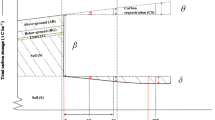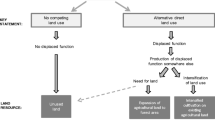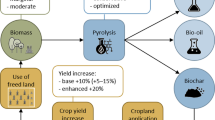Abstract
Purpose
In life cycle assessment (LCA), the impact assessment on natural resources is still in the early stages of research, and the impacts of biotic resources are usually not evaluated. The human appropriation of net primary production (HANPP) is a well-known indicator of land use impacts, but it cannot be easily implemented in LCA. The objective of this paper was to create a life cycle impact assessment (LCIA) method on land use impacts on net primary production (NPP) based on the HANPP approach.
Methods
To create an operational LCIA method, the midpoint characterization factors (CF) were calculated by comparing the NPP of plants occurring under current land uses with a baseline scenario, i.e., the NPP of potential natural vegetation. For the endpoint CF, we considered the backup technology concept and included in the calculation the marginal cost for additional biomass production through algae cultivation in the ocean.
Results and discussion
Site-generic and site-specific midpoint and endpoint characterization factors (CF) were created in a global scale for 162 countries and for four types of land uses (cropland, pasture, infrastructure, and wilderness). For cropland, we also created biomass-specific CF for ten particular crops in a global scale. The LCIA method was tested in particular case studies and seemed to produce comparable results, with the possibility of coupling it with other LCIA methodologies, as recipe endpoint.
Conclusions
The LCIA method proposed in this paper provides an assessment of the decrease of biomass availability due to land use (affecting the AoP resources), which is an impact category poorly considered in LCA. Nevertheless, the method has some future challenges, for instance to take into account site-specific backup technologies for the endpoint CF.





Similar content being viewed by others
Notes
The value of US$ is based on the year 2010
References
Alvarenga RAF, Dewulf J, Van Langenhove H, Huijbregts MAJ (2013a) Exergy-based accounting for land as a natural resource in life cycle assessment. Int J Life Cycle Assess 18:939–947
Alvarenga RAF, Dewulf J, Van Langenhove H (2013b) A new natural resource balance indicator for terrestrial biomass production systems. Ecol Indic 32:140–146
Beck T, Bos U, Wittstock B, Baitz M, Fischer M, Sedlbauer K (2010) LANCA—land use indicator value calculation in life cycle assessment—method report. LBP - Gabi, Fraunhofer IBP, Stuttgart
Brandão M, Mila i Canals L (2013) Global characterisation factors to assess land use impacts on biotic production. Int J Life Cycle Assess 18(6):1243–1252
Chiarucci A, Araújo MB, Decocq G, Beierkuhnlein C, Fernández-Palacios JM (2010) The concept of potential natural vegetation: an epitaph? J Veg Sci 21(6):1172–1178
de Baan L, Alkemade R, Koellner T (2013) Land use impacts on biodiversity in LCA: a global approach. Int J Life Cycle Assess 18(6):1216–1230
Dewulf J, Bosch ME, Meester BD, Vorst GV, Langenhove HV, Hellweg S, Huijbregts MAJ (2007) Cumulative exergy extraction from the natural environment (CEENE): a comprehensive life cycle impact assessment method for resource accounting. Environ Sci Technol 41(24):8477–8483
Dewulf J, Van Langenhove H, Muys B, Bruers S, Bakshi BR, Grubb GF, Paulus DM, Sciubba E (2008) Exergy: its potential and limitations in environmental science and technology. Environ Sci Technol 42(7):2221–2232
Ecoinvent (2010) Ecoinvent data v2.2.Ecoinvent reports No.1-25. Swiss Centre for Life Cycle Inventories, Dübendorf
Edwards M, Watson L (2011) Aquaculture explained—no 26—cultivating Laminaria digitata. Board, Irish Sea Fisheris
Erb K-H, Gaube V, Krausmann F, Plutzar C, Bondeau A, Haberl H (2007) A comprehensive global 5 min resolution land-use data set for the year 2000 consistent with national census data. J Land Use Sci 2(3):191–224
Erb K-H, Krausmann F, Gaube V, Gingrich S, Bondeau A, Fischer-Kowalski M, Haberl H (2009) Analyzing the global human appropriation of net primary production—processes, trajectories, implications. An introduction. Ecol Econ 69(2):250–259
European Commission (2011) International Reference Life Cycle Data System (ILCD) handbook—recommendations for life cycle impact assessment in the European context, 1st edn. European Commission - Joint Research Centre - Institute for Environment and Sustainability, Luxemburg
FAO (1997) State of the world's forest. Food and Agriculture Organization, Rome
FAOSTAT (2013) Food and Agriculture Organization of the United Nations
Frischknecht R, Steiner R, Jungbluth N (2009) The ecological scarcity method—Eco-factors 2006. A method for impact assessment in LCA. BundesamtfürUmwelt (BAFU), Bern
Goedkoop M, Spriensma R (2000) The Eco-indicator 99—a damage oriented method for life cycle impact assessment: methodology report. PRe Consultants, Amersfoort
Goedkoop M, Heijungs R, Huijbregts M, de Schryver A, Struijs J, van Zelm R (2009) ReCiPe 2008—a life cycle impact assessment method which comprises harmonized category indicators at the midpoint and the endpoint level. First edition. Report I: Characterisation
Guinée J (1995) Development of a methodology for the environmental life-cycle assessment of products. Leiden University, Leiden, The Netherlands
Haberl H, Erb K-H, Krausmann F, Gaube V, Bondeau A, Plutzar C, Gingrich S, Lucht W, Fischer-Kowalski M (2007) Quantifying and mapping the human appropriation of net primary production in earth's terrestrial ecosystems. Proc Natl Acad Sci U S A 104(31):12942–12947
Haberl H, Erb K-H, Krausmann F, Berecz S, Ludwiczek N, Martinez-Alier J, Musel A, Schaffartzik A (2009) Using embodied HANPP to analyze teleconnections in the global land system: conceptual considerations. Geogr Tidsskr-Dan J Geogr 109(2):119–130
Haberl H, Erb K-H, Krausmann F (2014) Human appropriation of net primary production: patters, trends, and planetary boundaries. Annu Rev Environ Resour 39:363–391
Hauschild M, Goedkoop M, Guinee J, Heijungs R, Huijbregts M, Jolliet O, Margni M, Schryver A, Humbert S, Laurent A, Sala S, Pant R (2013) Identifying best existing practice for characterization modeling in life cycle impact assessment. Int J Life Cycle Assess 18(3):683–697
Hischier R, Weidema B, Althaus H-J, Doka G, Dones R, Frischknecht R, Hellweg S, Humbert S, Jungbluth N, Loerincik Y, Margni M, Nemecek T, Simons A (2009) Implementation of life cycle impact assessment methods: final report ecoinvent v2.1, vol 3. Swiss Centre for Life Cycle Inventories, St. Gallen, Switzerland
ISO (2006) ISO International Standard 14040: environmental management—life cycle assessment—principles and framework. International Organization for Standardization, Geneva
Klinglmair M, Sala S, Brandão M (2014) Assessing resource depletion in LCA: a review of methods and methodological issues. Int J Life Cycle Assess 19:580–592
Koellner T, Scholz RW (2008) Assessment of land use impacts on the natural environment: Part 2: generic characterization factors for local species diversity in central Europe. Int J Life Cycle Assess 13(1):32–48
Lauenroth W, Wade A, Williamson M, Ross B, Kumar S, Cariveau D (2006) Uncertainty in calculations of net primary production for grasslands. Ecosystems 9(5):843–851
Machado LCP (2010) Pastoreio racional voisin: tecnologia agroecológica para o terceiro milênio. Expressão Popular, São Paulo
Mattila T, Helin T, Antikainen R (2012) Land use indicators in life cycle assessment. Int J Life Cycle Assess 17(3):277–286
Michelsen O (2008) Assessment of land use impact on biodiversity: proposal of a new methodology exemplified with forestry operations in Norway. Int J Life Cycle Assess 13(1):22–31
Mila i Canals L, Romanya J, Cowell SJ (2007) Method for assessing impacts on life support functions (LSF) related to the use of ‘fertile land’ in life cycle assessment (LCA). J Clean Prod 15:1426–1440
Milà i Canals L, Chenoweth J, Chapagain A, Orr S, Antón A, Clift R (2009) Assessing freshwater use impacts in LCA: part I—inventory modelling and characterisation factors for the main impact pathways. Int J Life Cycle Assess 14(1):28–42
Monfreda C, Ramankutty N, Foley JA (2008) Farming the planet: 2. Geographic distribution of crop areas, yields, physiological types, and net primary production in the year 2000. Glob Biogeochem Cycles 22(1):1–19
Núñez M, Antón A, Muñoz P, Rieradevall J (2013) Inclusion of soil erosion impacts in life cycle assessment on a global scale: application to energy crops in Spain. Int J Life Cycle Assess 18(4):755–767
Pfister S, Koehler A, Hellweg S (2009) Assessing the environmental impacts of freshwater consumption in LCA. Environ Sci Technol 43(11):4098–4104
Saad R, Koellner T, Margni M (2013) Land use impacts on freshwater regulation, erosion regulation, and water purification: a spatial approach for a global scale level. Int J Life Cycle Assess 18(6):1253–1264
Schmidt JH (2008) Development of LCIA characterisation factors for land use impacts on biodiversity. J Clean Prod 16:1929–1942
Stewart M, Weidema BP (2005) A consistent framework for assessing the impacts from resource use—a focus on resource functionality. Int J Life Cycle Assess 10(4):240–247
Swart P, Alvarenga RAF, Dewulf J (2014) Abiotic resource use. In: Hauschild M, Huijbregts MAJ (eds) Encyclopedia of LCA, Volume IV: life cycle impact assessment. Springer press (submitted)
Tüxen R (1956) Die heutigepotentiellenatürliche Vegetation als Gegenstand der Vegetationskartierung. Angew Pflanzensoziologie 13:5–42
United Nations (1987) Our common future: report of the world commission on environment and development. United Nations
United Nations (2013) World population prospects: the 2012 revision, United Nations, Department of Economic and Social Affairs, Population Division. Accessed September, 2013
USIC (2014) United States Inflation Calculator. Coinnews media group LLC (Coin News). http://www.usinflationcalculator.com/. Accessed in 19/08/2014
Voisin A (1959) Grass productivity. Inland Press, Washington
Wang W, Dungan J, Hashimoto H, Michaelis AR, Milesi C, Ichii K, Nemani RR (2011) Diagnosing and assessing uncertainties of terrestrial ecosystem models in a multimodel ensemble experiment: 1. Primary production. Glob Chang Biol 17(3):1350–1366
Williams M, Rastetter EB, Shaver GR, Hobbie JE, Carpino E, Kwiatkowski BL (2001) Primary production of an Arctic watershed: an uncertainty analysis. Ecol Appl 11(6):1800–1816
Zhang Y, Singh S, Bakshi BR (2010) Accounting for ecosystem services in life cycle assessment, Part I: a critical review. Environ Sci Technol 44(7):2232–2242
Acknowledgments
This project is partly funded by CAPES/Brazil, Programa Ciência Sem Fronteiras (Atração Jovens Talentos), and Euro-Brazilian Window II (EBWII) Project from Erasmus Mundus program. Helmut Haberl and Karl-Heinz Erb gratefully acknowledge the funding by the Austrian Science Fund (FWF), project P20812-G11, the European Research Council, ERC Starting Grant 263522 LUISE, as well as by the EU-FP7 project VOLANTE.
Author information
Authors and Affiliations
Corresponding author
Additional information
Responsible editor: Llorenc Milà i Canals
Electronic supplementary material
Below is the link to the electronic supplementary material.
ESM 1
(XLSX 77 kb)
Rights and permissions
About this article
Cite this article
Alvarenga, R.A.F., Erb, KH., Haberl, H. et al. Global land use impacts on biomass production—a spatial-differentiated resource-related life cycle impact assessment method. Int J Life Cycle Assess 20, 440–450 (2015). https://doi.org/10.1007/s11367-014-0843-x
Received:
Accepted:
Published:
Issue Date:
DOI: https://doi.org/10.1007/s11367-014-0843-x




